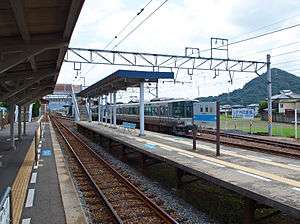Hashioka Station
Hashioka Station (端岡駅, Hashioka-eki) is a railway station on the Yosan Line in Takamatsu, Kagawa Prefecture, Japan. It is operated by JR Shikoku and has the station number "Y03".[1][2]
Hashioka Station 端岡駅 | |
|---|---|
 Hashioka Station in 2010 | |
| Location | Kokubunjicho Nii, Takamatsu-shi, Kagawa-ken 769-0101 Japan |
| Coordinates | 34°18′17″N 133°58′05″E |
| Operated by | |
| Line(s) | ■ Yosan Line |
| Distance | 9.5 km from Takamatsu |
| Platforms | 1 side + 2 island platforms |
| Tracks | 4 + 2 sidings |
| Construction | |
| Structure type | At grade |
| Disabled access | No - island platforms accessed by footbridge |
| Other information | |
| Status | Staffed - JR ticket window |
| Station code | Y03 |
| History | |
| Opened | 21 February 1897 |
| Location | |
 Hashioka Station Location within Japan | |
Lines
The station is served by the JR Shikoku Yosan Line and is located 9.5 km from the beginning of the line at Takamatsu.[3] Yosan line local, Rapid Sunport, and Nanpū Relay services stop at the station. The Marine Liner rapid service on the Seto-Ohashi Line between Okayama and Takamatsu also stop at the station. Although Tadotsu is the official start of the Dosan Line, some of its local trains start from and return to Takamatsu. These trains also stop at Hashioka.[4]
Layout
The station consists of a side platform and two staggered island platforms serving four tracks. The side platform, attached to the station building is designated platform 0. Track 1 is served by both platform 0 and platform 1 (island) and trains stopping there occasionally open their doors on both sides to allow passengers to quickly get from the island platform to the station building. Platforms 1 and 2 serve eastbound trains while platforms 3 and 4 serve westbound ones. A station building houses a waiting room and a JR ticket window (without a Midori no Madoguchi facility). Access to the island platforms is by means of two footbridges, one for each island. Two sidings branch of off the main tracks on either side.[2][3][5]
Adjacent stations
| « | Service | » | ||
|---|---|---|---|---|
| Yosan Line | ||||
| Limited Express Uzushio: Does not stop at this station | ||||
| Kinashi | Rapid Sunport | Kokubu | ||
| Kinashi | Rapid Nanpū Relay | Kokubu | ||
| Kinashi | Local | Kokubu | ||
| Dosan Line | ||||
| Kinashi | Local | Kokubu | ||
| Seto-Ōhashi Line | ||||
| Kinashi | Rapid Marine Liner | Kokubu | ||
History
The station opened on 21 February 1897 as an intermediate stop when the track of the privately Sanuki Railway (later the Sanyo Railway) was extended from Marugame to Takamatsu. After the railway as nationalized on 1 December 1906, Japanese Government Railways (JGR) took over the station and operated it as part of the Sanuki Line (later the Sanyo and then the Yosan Main Line). With the privatization of Japanese National Railways (JNR, the successor of JGR) on 1 April 1987, control of the station passed to JR Shikoku.[6][7]
See also
- List of Railway Stations in Japan
References
- "Shikoku Railway Route Map" (PDF). JR Shikoku. Retrieved 27 December 2017.
- "端岡" [Hashioka]. hacchi-no-he.net. Retrieved 27 January 2018.
- Kawashima, Ryōzō (2013). 図説: 日本の鉄道 四国・九州ライン 全線・全駅・全配線・第1巻 四国東部エリア [Japan Railways Illustrated. Shikoku and Kyushu. All lines, all stations, all track layouts. Volume 1 Eastern Shikoku] (in Japanese). Kodansha. pp. 18, 77. ISBN 9784062951609.
- "Hashioka Station Timetable" (PDF). JR Shikoku. Retrieved 27 January 2018.
- "端岡駅" [Hashioka Station]. shikoku.org.uk. Retrieved 27 January 2018.
- Ishino, Tetsu; et al., eds. (1998). 停車場変遷大事典 国鉄・JR編 [Station Transition Directory - JNR/JR] (in Japanese). II. Tokyo: JTB Corporation. p. 631. ISBN 4533029809.
- Ishino, Tetsu; et al., eds. (1998). 停車場変遷大事典 国鉄・JR編 [Station Transition Directory - JNR/JR] (in Japanese). I. Tokyo: JTB Corporation. pp. 213–215. ISBN 4533029809.
| Wikimedia Commons has media related to Hashioka Station. |